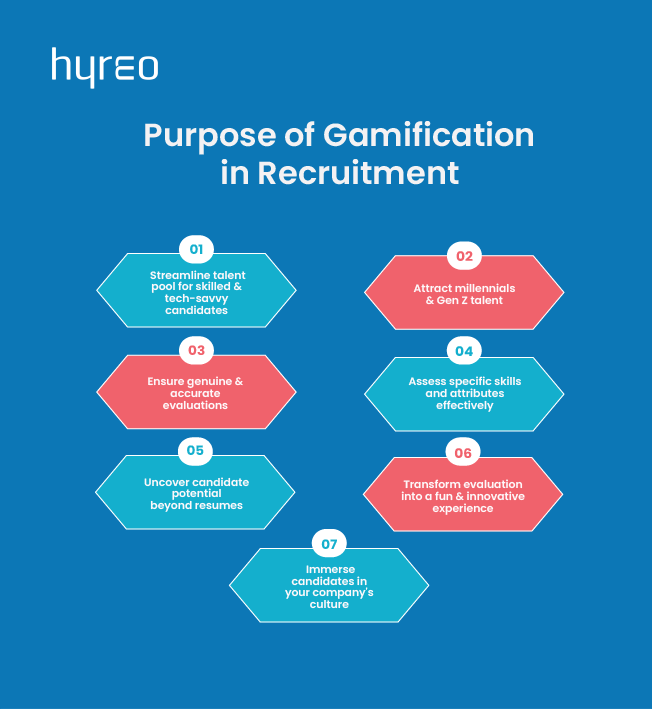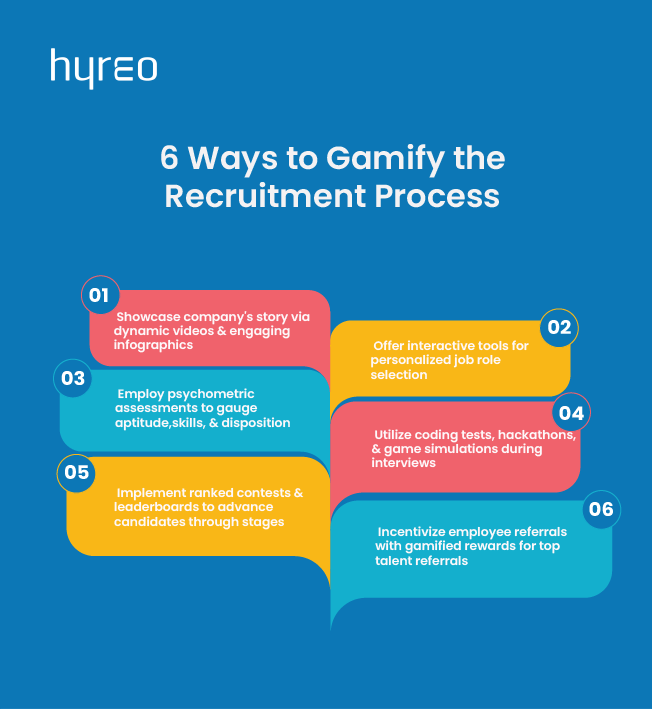Key takeaways
Attempting an interview can be pretty grueling for job seekers.
At the same time, recruiters have challenges getting the right talent into the organizations. Traditional methods of interviewing have their pros. However, several challenges can be overcome by a creative technique called gamification.
As you read through, you will know:
Traditional interviewing methods can be complex in volume hiring, creating additional pressure on interviewers. They may end up being time-consuming and expensive. Traditional interviewing can also have unconscious bias, which makes the process ineffective.
While not wholly dismissing its advantages, the essential elements of interviewing can be transformed to make the process more efficient and engaging for both recruiters and candidates.
Gamification (in recruitment) can be defined as using games or game-like interactive activities to engage, evaluate and motivate a candidate to respond to challenges or questions posed.
Some gamification activities include:

Gamification can be a great differentiator to stand out as a unique employer brand. With employers offering excellent candidate experiences during recruitment, gamification can help make your hiring process memorable.
HR World highlights survey findings from Talent LMS, revealing that over 78% of candidates believe gamification in the recruitment process makes a company more desirable. Apart from building a positive employer brand, it has the following advantages:
Gamification is often appealing to skilled and tech-savvy candidates who accept complex challenges. If gamification is introduced as early as applying for a job, the relatively less interested ones will most likely drop off. This will narrow your talent pool to relevant candidates.
Millennials and Gen Z, who extensively use technology in their everyday routine, are likely to be attracted to organizations using gamification.
Standard interview questions can elicit rehearsed and memorized responses from candidates.
Gamification can put a candidate on the spot and make them respond more naturally to presenting challenges.
Through various games and activities, candidates can be evaluated for specific skills like problem-solving, time management, creativity, and even subtler attributes like stress management, empathy, and even patience.
Beyond the basic criteria, gamification can help you identify talent despite the lack of education or experience. Organizations that don’t mind investing in training and development can be highly benefited by adopting gamification.
The term interview itself can be quite stressful for many candidates, which adversely affects their performance. Gamification helps in reducing such pressure by introducing fun, creativity, and engagement.
Several companies offer a virtual tour to the candidates, which helps them understand how their routine may be or get a glimpse of the value proposition offered.

Gamification can be used right from sourcing till the final stages of interviewing. Some companies extend it to onboarding as well.
Here is how you can introduce gamification in your hiring process:
Many brands have introduced storytelling through videos and infographics to educate candidates about what may be in store for them. By narrating the company’s origin, history, and journey, you can build a great connection with candidates and inspire them to associate with you. Stories are also a great way of making your brand appealing and memorable.
Companies that have adopted gamification have unhesitatingly introduced it right from the early stages of recruitment. Deloitte offers the “Explore your fit” idea to candidates that help them understand which job roles are best suited for them. The company also has a recruiting video that educates candidates about what they can expect in the organization.McDonald’s created a customizable filter on Snapchat and invited interested applicants to create and submit a 10-second application called ‘Snaplications,’ talking about themselves and why they would make good employees.
Psychometrics, which loosely means measuring the mind, is a simple way of evaluating basic criteria in candidates. Tests, interactive quizzes, puzzles, or riddles can be used to evaluate aptitude, skills, and temperament for initial screening.
It also has the advantage of quantifying the attributes to help in data-driven decision-making. The outcome of these tests can also be conversation cues for interviewers in the further rounds.
Since this is an elaborate stage in hiring, the activities are also more challenging and complex. The activities evaluate skills and values expected for a role and the organization. Coding tests, hackathons, and simulated games give a clear picture of the candidate’s potential.
Google is famous for presenting riddles, puzzles, and coding tests to its candidates. Marriott introduced a virtual simulation of a hotel manager’s job.
Companies with a streamlined recruitment process also conduct assessment centers, where candidates are evaluated individually and in groups.
Complex activities such as in-trays, SJTs, case studies, and business simulations can be conducted with experienced candidates.
If various activities are conducted in the different interview stages, you can maintain scoreboards to quantify the candidate’s potential.
Many companies also conduct contests and competitions, and ranked scoreboards are created. You can create benchmarks in each activity that qualify candidates for further rounds, streamlining your process. Gamification can be multi-layered, where successful completion of each activity can earn points or rewards for candidates.
Gamification can also be included to encourage employee referrals. A reward system can be used to motivate employees to refer other skilled candidates.

Is your organization passionate and serious or creative and quirky? You can portray your brand to connect with candidates who may resonate with your vision and values. Ensure that what you portray is also authentic and reliable.
This is the most important aspect, regardless of your interviewing method. The clearer your parameters are, the easier the process will be. This will also help you choose the right activities for assessment. You could also set benchmarks for the activities so that filtering candidates will be easier for you.
Ensure that your activities are aligned with your evaluation parameters. Include only those activities that are not only engaging for candidates but also helpful in decision-making.
Several gamification tools can help you right from candidate application to onboarding. These tools also help you understand where a candidate is in the hiring process as well as their scores in each of the activities. You can also generate reports that help in increasing efficiency.
If you are introducing a unique interviewing method, communicate it to your candidates. Although you may not reveal too many details about the activities, candidates can be mentally prepared for a different kind of assessment.
Gamification can be a wonderful way of evaluating and engaging candidates at the same time. These games and activities can make the interview process less stressful for the candidates, making the brand memorable (to say the least).
For recruiters, gamification helps in eliciting natural responses from candidates, making the interview process easier, less time-consuming, and more efficient.
If gamification is implemented in a planned and organized way, it can truly be a win-win for both candidates and employers.
The benefits of implementing gamification are many; however, there are a few challenges you may face:
Investment of time and resources: When gamification is implemented for the first time, it will need a lot of time and human involvement. Also, creating relevant activities needs expertise, which may not be readily available. Thus, gamification has a longer implementation time.
Technical glitches: If you use technology for gamification, a common challenge is the presence of technical problems or glitches, and fixing them needs expertise. A lapse in the process due to glitches may adversely affect the candidate’s experience. Conducting enough pilot or testing sessions before going live can help you anticipate common challenges and be prepared with workarounds.
Some common myths about gamification are that it is only for younger candidates. On the contrary, it can attract skilled and experienced candidates, depending on the complexity of activities and games.
Since it is different from the usual interviewing methods, it may seem tedious, expensive, and time-consuming. However, the reality is that it is a creative way that will make your process objective, efficient and engaging.